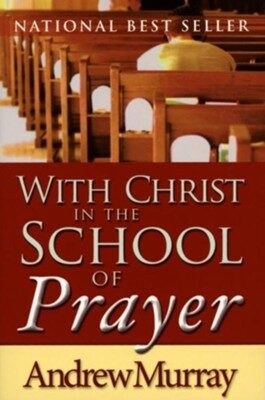Recently I was part of a study group led by Bob Japenga for which the resource book was Andrew Murray’s classic, With Christ in the School of Prayer (1953, Fleming H. Revell). I profited greatly from the class. I had read this motivational little book early in my years of ministry, but I soon found that it is definitely among those classics where rereading profits greatly. In testimony to its classic status, it is still available today from multiple publishers.
I was immediately attracted again to the “Biblical theology” method of the writer. He does not start with axioms about prayer, though he provides many. Nor does he launch his discussion from philosophy or even theology though he interacts with the latter instructively. Rather, he starts with the Bible which is the best and most helpful place to start in learning to pray. “As we meditate on the words He spoke on earth, let us yield ourselves to His teaching in the fullest confidence that, with such a teacher, we shall make progress”(p. 16).
One key attraction is that Murray constantly draws us beyond ourselves, stretching us toward a higher goal. One can see this in what might be called the book’s premise, “It is on prayer that the promises wait for their fulfillment, the kingdom for its coming, the glory of God for its full revelation”(p. 14). Murray makes us feel our own work of intercession is of great worth.
Each chapter closes first with the humble prayer of Jesus’ disciples which also becomes our prayer as readers, “Lord, teach us to pray!” Then there follows a written prayer from Murray helping us to pray into the key points of that chapter. As I have grown older, I have appreciated more and more the written prayers of others to broaden the scope and increase the creativity and expressiveness of my own prayers.
I am challenged by Murray’s writings on faith and prayer, but I discovered that Andrew Murray must be read carefully, or one will only get part of the picture. For example, in the beginning of Lesson Eleven as the short chapters are called, one would first think Murray is strongly saying that whenever prayer isn’t answered, one just doesn’t have enough faith. “He [Jesus] wants his oft repeated ‘ALL THINGS’ to into enter our hearts and reveal to us how mighty the power of faith is, how truly the Head calls the members to share with Him in His power, how wholly the Father places his power at the disposal of the child that wholly trusts him” (p. 61). But a closer read will reveal that a simplistic interpretation does not reflect the Biblical nuances of Murray’s writing. Just a few sentences later, Murray begins to explain the adjustments that we understand from other Biblical texts. “Ere we can believe, we must find out and know what God’s will is”(p. 62). And then the insightful “It is in prayer that we hold up our desire to the light of God’s Holy Will, that our motives are tested and proof given whether we ask indeed in the name of Jesus and only for the glory of God”(p. 62). Overall, I found Murray’s thoughts on the interrelationship between faith, God’s Word, prayer, and God’s will to be very helpful. For example, “Faith needs a life of prayer for its full growth”(p. 72).
Two Lessons from With Christ in the School of Prayer highlight Murray’s powerful comprehension of the Trinity and prayer, lessons twenty-five and twenty-six. “The eternal never ceasing giving to the Son which is the Father's prerogative and the eternal asking and receiving which is the Son's right and blessedness–it is through the Spirit that this communion of life and love is maintained. It has been so from all eternity. It is so especially now, when the Son as Mediator ever liveth to pray. The great work which Jesus began on earth of reconciling in his own body God and man, He carries on in heaven…It is to do this that He ever liveth to pray; in His unceasing intercession He places Himself in living fellowship with the unceasing prayer of his redeemed ones. Or rather, it is His unceasing intercession which shows itself in their prayers, and gives them a power they never had before (p. 141). Reflecting on this paragraph alone will add immense depth to our praying.
Over and over as one reads this book, the role of prayer as intercession is magnified and the reader finds continual encouragement for both personal and corporate prayer life. The value in reading or rereading Murray’s classic and of being in a class like Bob Japenga's is that one finds oneself desiring to pray and to grow in prayer too. This book stokes our desire to spend time with God. I highly recommend it. Overlook the slight work of thicker prose and older English vocabulary and warm your soul’s ardor with its gentle appeals.
